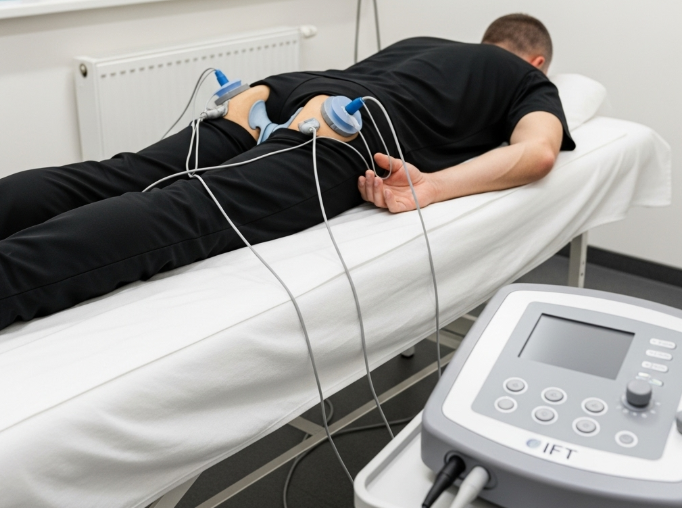Is Sacroiliitis pain disrupting your daily life, making simple movements a challenge? We understand the frustration
of that persistent ache in your lower back, buttocks, or even down your leg. The emotional toll of chronic pain,
including frustration, anxiety, and even depression, can be significant. You're not alone, and we're here to help.
This blog post will provide a clear understanding of Interferential Therapy (IFT) and how it can be a valuable tool in
managing Sacroiliitis pain. We'll explore what IFT is, how it works and how it fits into a comprehensive treatment plan,
all within the scope of physiotherapy practice. Our goal is to empower you with knowledge, offering a non-invasive
approach to relief and improved function.
Understanding Sacroiliitis and SI Joint Pain
Sacroiliitis involves inflammation of one or both sacroiliac joints, where the spine connects to the pelvis. This
inflammation can trigger a range of symptoms, primarily pain in the lower back and buttocks. The pain can
sometimes radiate down the legs, mimicking sciatica, and can be triggered or worsened by activities like
prolonged sitting, standing, or climbing stairs. Back pain can also be related to issues in your spine, muscles,
or nerves. Uncovering the root cause of your pain is the crucial first step toward effective relief. A thorough
assessment by a physical therapist, is essential to determine the underlying cause of your pain and develop
an appropriate treatment strategy.
Back pain happens when something in your spine, muscles, or nerves gets irritated or injured. It can make daily
activities hard and uncomfortable. Treatments like physical therapy, medications, or exercises, including Interfer-
ential therapy for back pain, help by reducing pain, improving strength, and restoring movement. Understanding
what causes your back pain is the first step in finding the right treatment. Different methods, such as Interferential
Therapy for Back Pain, target the specific issues causing your pain, helping you get back to your normal activities.
What is Interferential Therapy (IFT)?
Interferential Therapy (IFT) is a non-invasive electrotherapy treatment used to alleviate pain, reduce muscle
spasms, and promote tissue healing. It's a common application of Interferential therapy for back pain. IFT utilizes
two or more medium-frequency electrical currents that "interfere" with each other to create a lower-frequency
current within the tissues. This lower frequency current stimulates the body's natural pain-relieving mechanisms.
Unlike some other forms of electrotherapy, IFT uses a higher frequency current that penetrates deeper into the
tissues with less discomfort.
How IFT Works for SI Joint Pain Relief
IFT tackles pain on several levels, offering relief for Sacroiliitis sufferers. First, the electrical stimulation helps to
modulate the transmission of pain signals from reaching the brain. This is achieved by stimulating sensory nerves,
which can override the transmission of pain signals. Second, IFT can help to reduce muscle spasms and tension
around the SI joint. By stimulating the muscles, IFT can promote relaxation and reduce the tightness that often
contributes to pain. Third, IFT can improve local blood flow to the affected area. Increased blood flow brings more
oxygen and nutrients to the tissues, which can promote healing and reduce inflammation.
Safety, Side Effects, and Integration with Other Treatments
IFT is generally considered a safe treatment modality with minimal side effects. Some people may experience mild
skin irritation or redness at the electrode placement sites, but this usually resolves quickly. It's crucial to inform
your therapist of any pre-existing medical conditions, such as pregnancy, pacemakers, or metal implants, as these
may be contraindications for IFT. Certain conditions require careful consideration before using electrotherapy.
IFT is often used as part of a comprehensive treatment plan for Sacroiliitis. It can be
effectively combined with other physiotherapy techniques, such as manual therapy, therapeutic exercises, and
postural correction.
Pregnant women and individuals with specific medical conditions should consult their healthcare provider before
starting IFT. Always discuss your health history with your therapist to ensure IFT is safe for you. IFT can be
combined with physical therapy, medication, or exercise to augment overall results. Combining these treatments
targets different parts of the process of pain and recovery. For example, IFT is majorly involved in reducing
pain and relaxing muscle tightness, whereas physical therapy strengthens muscles and improves mobility.
These combined approaches will, therefore, offer a more potent and comprehensive treatment regime for the
management of back pain.
Complementary Exercises for Sacroiliitis Relief
While IFT can provide significant pain relief, incorporating specific exercises into your routine is crucial for
long-term management of Sacroiliitis. These exercises aim to strengthen the muscles around the SI joint, improve
flexibility, and promote proper alignment. It's essential to consult with a physical therapist to learn the correct form
and progression for these exercises. They can tailor an exercise program to your specific needs and limitations,
ensuring that you're performing the exercises safely and effectively. Remember, consistency is key when it comes
to exercise. Aim to incorporate these exercises into your daily routine to maintain long-term pain relief and prevent
future flare-ups.
Conclusion
Interferential Therapy (IFT) offers a promising, non-invasive approach to managing Sacroiliitis pain and improving
function. By understanding how IFT works and what to expect during a session, you can make informed decisions
about your treatment options. Remember, IFT is often most effective when combined with other physiotherapy
techniques and a tailored exercise program. Consulting with a qualified physical therapist is the first step towards
finding lasting relief and regaining your quality of life. Don't let SI joint pain hold you back – take proactive steps
towards a pain-free future with personalized care, powered by innovation.
